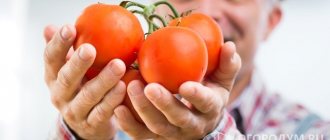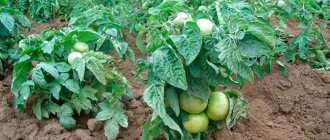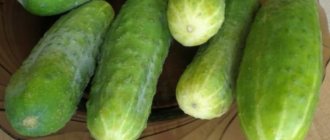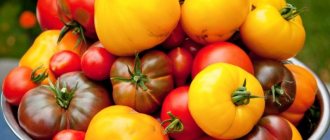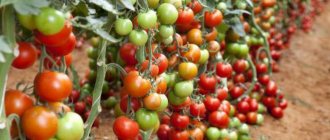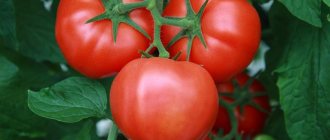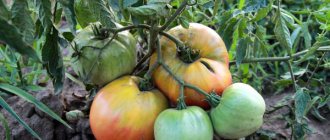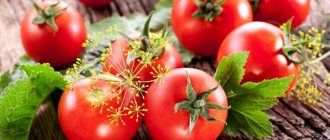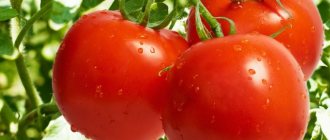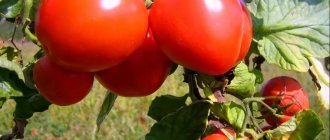Getting a huge harvest of juicy, tasty and healthy tomatoes in cold climates is not luck, not professionalism, but an adequately selected variety. For cold regions, where daylight hours are much less than night, not every type is suitable. These should be tomatoes of Siberian selection for greenhouse and greenhouse cultivation, early in terms of early ripening. In such a climate, the days are always short, and plant crops must not only grow, but also bear fruit. The review describes tomato varieties of Siberian selection for 2022.
Advantages
Every year, frost-resistant varieties are becoming increasingly popular among gardeners. They were specially bred for Siberia, therefore they differ in the following characteristics:
- disease resistant;
- high-yielding;
- ripen quickly in short summer conditions;
- tolerate temperature changes well;
- do not require a lot of sunlight, despite the fact that tomatoes are heat-loving crops.
These varieties are suitable for cultivation in the Urals, as well as in the regions of central Russia and in risky slowdown zones, where summer is not particularly pampering with warmth and sun.
Tomatoes for greenhouses
The best varieties from Siberian breeders, which are more suitable for growing in a greenhouse, are:
- Pride of Siberia . Refers to an early ripening species. It grows as a determinate bush up to 160-170 cm high and requires staking. Used exclusively for planting in greenhouses. Bushes require good and timely fertilizer. It is recommended to plant according to this scheme: 4-5 bushes per 1 square meter. m. The plant bears fruits of bright red color, reaching gigantic sizes - up to 900 g.
- Siberian abundant . Also applies to early ripening plants. It is characterized by high productivity - it produces up to 5-6 kg of fruit from one bush, and the weight of one tomato is about 150-200 g. They have a red-crimson color and a dense structure. The bushes grow up to 170 cm, and up to 7 fruiting clusters are formed on each of them. The outer flowers need to be pinched to allow the remaining fruits to ripen to the correct size.
- Nobleman . Ripens at 113-117 days. Tomatoes grow large - from 300 to 500 g. Some of them can even grow up to 1 kg. Tomatoes are heart-shaped, raspberry-pink in color and have a sweet, rich taste. They are great for winter preparations. The plant gives a good harvest - from 1 sq. m. can be collected from 3 to 6 kg. The variety is resistant to diseases and tolerates low temperatures well.
- A great warrior . The variety received this name due to the fact that it bears fruit with large raspberry tomatoes - weighing about 500 g. It is an early ripening variety, so if you plant it in a heated structure in March, you can get the first harvest in May. In general, its growing season is up to 3 months.
- Alsou . It is one of the most popular tomatoes of Siberian breeders, which bears fleshy and large fruits - the average weight is 500 g. The bushes grow small - up to 80 cm in height. In general, tomatoes are sweet, but have sour notes. From 1 sq. m. you can harvest up to 9 kg of crop. Tomatoes have an excellent presentation and tolerate transportation well.
Tomato variety “Pride of Siberia”
Siberian abundant type of tomato
Variety "Velmozha"
Tomato variety "Great Warrior"
Tomato variety "Alsu"
In order for the seedlings of the listed varieties to actively develop, it is recommended to use special growth stimulants for the seedlings.
Varieties for open ground from different agricultural companies
They are produced by several agricultural companies, so the products of each of them should be considered separately.
Siberian Garden
Gardeners prefer the following varieties:
- Siberian surprise . Refers to mid-early and multiple-fruited plants - 10 fruits are formed on each cluster. On average, the bush reaches a height of 100-120 cm and requires pinching. Tomatoes have an elongated shape, called pepper-shaped, and weigh up to 130 g. They are excellent for both whole canning and for preparing salads.
- Siberian apple . Also refers to mid-early high-yielding varieties that bear fleshy pearl-pink fruits with a high sugar content. The bushes have a height of 150 to 180 g. Per 1 sq. m. it is recommended to plant up to 3 bushes. The variety is also suitable for growing in a greenhouse.
- Siberian Malachite . It bears fruits weighing between 120 and 160 g and yellow-green in color, which are sweeter in taste than many red tomatoes. The bushes of the plant grow up to 120-190 cm.
- Novosibirsk Hit . This is a hybrid that produces bright red tomatoes that are highly disease resistant. The bushes reach a height of up to 100 to 150 cm, and the fruits weigh up to 500 g. The pulp is fleshy and fragrant with a small amount of seeds.
Mid-early tomato variety “Siberian Surprise”
High-yielding tomato variety "Siberian Apple"
Yellow-green tomato variety “Siberian Malachite”
Highly disease-resistant hybrid “Novosibirsk Hit”
Altai seeds
The agricultural company presents the following varieties:
- King of Siberia . It is a mid-season plant that is recommended to be grown in an open garden bed. The bushes of the plant reach a height of 100 to 150 cm, so they can be easily covered with film. It belongs to large-fruited varieties - the weight of one tomato can reach 800-900 g. The fruits have a bright yellow color and a heart-shaped shape. Seedlings are planted in open ground on the 60-65th day, when one flower cluster and 6-7 true leaves appear.
- Chinese disease resistant . A new early ripening variety characterized by high disease resistance. The bushes of the plant are determinate. They ripen tomatoes that are round in shape, weigh up to 200 g and have a bright red color.
- Bulls-eye . An early-ripening, abundantly fruiting variety that bears small cherry-shaped tomatoes. Each cluster produces 10-40 small fruits (weight up to 30 g). The bushes can reach up to 200 cm in height.
- Rugby . It is a hybrid that produces dense fruit for canning. The bushes grow up to 100 cm in height. 5-7 fruits ripen on one cluster. On average, their weight is 90-100 g.
Mid-season tomato variety “King of Siberia”
Early maturing tomato variety "Chinese disease-resistant"
Tomato variety "Bull's eye"
Variety "Rugby"
Russian vegetable garden
The agricultural company produces an early maturing hybrid Date Siberian F1. The bushes of the plant are determinate, have a height of about 60 cm and a width of 40 to 50 cm. The fruits grow small - weighing up to 20 g. In this regard, the variety can be used for growing not only in an open garden bed, but also on a loggia.
Aelita
A popular variety of this selection is the Siberian miracle. It is a mid-season plant with indeterminate bushes with a height of 100 to 120 cm. It is recommended to plant them in two stems. It bears fruits that are ovoid in shape and of average weight - up to 150 g. The variety is characterized by high yield - from 1 sq. m. you can collect about 9 kg. Tomatoes are great for harvesting.
Diseases and pests
Varietal tomatoes are often susceptible to diseases. If you let them go, you can lose the entire harvest. Most often, tomatoes are affected by rot and bacterial infections.
Late blight
Phytophthora is a microorganism that is especially dangerous for tomatoes in August, when rains begin in Siberia and daytime temperatures drop to 15–18 °C. This is the most favorable environment for sporulation. In a greenhouse, late blight can be combated using a heater - temperatures above 20–22 °C prevent the infection from spreading.
Correct crop rotation will help reduce the risk of late blight.
Preventive spraying with fungicides should begin a few days after planting the seedlings in the ground.
Tomatoes affected by late blight are unsuitable for consumption
Gardeners consider the drug Profit Gold, which has a systemic effect, to be the best option. Repeated spraying should be done after 10–12 days. Plants are treated with Abiga-Pik or a 1% solution of Bordeaux mixture at intervals of 5–7 days. Tomato processing stops 2-3 weeks before harvest.
Tobacco mosaic
Tobacco mosaic is a viral disease. It affects not only tomatoes. If you have a diseased plant on your property, the virus can get onto the tomatoes through tools, gloves, and even clothing. Pests can also be carriers - aphids, thrips, cicadas.
The first signs of infection on tomato leaves are the appearance of a variegated color, where light and dark green-yellow areas alternate
It is impossible to treat tomato mosaic. The only way out is to destroy the diseased plant along with a lump of earth to prevent infection of all plantings. Weeds growing nearby are also destroyed. Plant residues are burned, and the land is treated with a 5% solution of potassium permanganate.
For prevention, healthy plants are sprayed with a mixture of whey and urea (1 tablespoon each), 40 g of laundry soap and 10 liters of water. If you find pests, you need to spray the bushes with Commander Maxi, Inta-Vir or Iskra M.
Cladosporiosis
Cladosporiosis is a dangerous fungal disease that affects the leaves and stems of tomatoes. Greenhouse tomatoes get sick more often. The causative agent of cladosporiosis feels best in a cold, damp environment, so it is important to maintain a consistently warm microclimate in the greenhouse and avoid high humidity. Spores are introduced through watering or through gardening tools.
If you find a diseased plant, it is better to replant it in open ground, otherwise you may lose most of the harvest
The first signs appear at the moment of flowering and formation of the ovary. If the disease is started, the leaves begin to fly off, and the fruits lose their ability to photosynthesize and form incorrectly. Gradually the plant completely withers.
As a preventative measure, the temperature in the greenhouse should be maintained at 25–28 °C and humidity no higher than 70%. Leaves affected by the fungus should be removed immediately. In the fall, collect and burn all remaining tops. For prevention and treatment, use a 1% solution of Bordeaux mixture, the drugs Fitosporin-M, Pseudobacterin-2, Vibrance Integral.
Video: tomato diseases and their treatment
How to choose?
As you can see, there are many varieties of Siberian selection, and in order to choose the most suitable seeds, you should proceed from a number of important parameters:
- Maturing period . In case of a short summer period, early ripening seeds will be more suitable. Three months are enough for such plants to grow and produce a harvest.
- Types of seeds . They can be of two types - varietal or hybrid. Varietal tomatoes of Siberian selection are more hardy plants and seeds can be collected from tomatoes and planted next year. Hybrids require crossing in order to germinate well, bear fruit and be resistant to disease. Thus, hybrids may not leave “hardy” offspring.
- Type of bush . Varieties of Siberian selection can be standard, semi-standard, indeterminate, determinate, etc. In addition to indeterminate, all other types have a low, strong stem that bends only under its own load. Ordinary determinate varieties are characterized by continuous growth and abundant harvest. If the bushes reach 2.5 m in height, they will have to be tied up even without fruits, otherwise they will fall to the ground.
When choosing varieties, you should also take into account the purpose of using tomatoes, because some of them are more suitable for fresh consumption, others for canning, and others for long-term storage and transportation.
Why Siberian selection is the best
Most seed companies produce varieties with high yields, but instability to changes in the environment. In Siberian conditions it is difficult to grow any crops. All plants must have a hardening, short growing season to survive. Sun deficiency affects vegetable crops. Several decades ago, breeders from Siberia needed to develop adaptive varieties of vegetable crops. After positive and negative attempts, the originators managed to develop resistant varieties. Selection tomatoes are characterized by:
- short growing season. Plants begin to bear fruit in the second month after seed germination;
- low temperatures do not affect the growth and development of vegetable crops;
- tomatoes have stable immunity;
- Tomatoes of Siberian selection are very productive.
